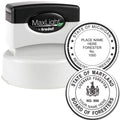Whether you’re labeling your kids’ clothes, personalizing your DIY tote bag, or adding a finishing touch to a homemade gift, a clothing stamp can make all the difference. This simple yet versatile tool is designed to leave a clear, lasting impression on fabric, giving you a neat way to mark everything from T-shirts to napkins. If you’ve ever juggled sticky labels that refuse to stay put, or if you’ve tried freehand fabric paint and ended up with a smudge, then a clothing stamp is the easy, hassle-free alternative you’ve been looking for.
Below, you’ll discover how to choose the right materials, design your perfect stamp, and apply it with confidence. You’ll also see why ESS has stood out as a leading supplier of cloth marking stamps, offering family-owned expertise and speedy service for six decades. Let’s dive into the essentials of selecting and using your new clothing stamp so you can make your mark in style.
Discover Clothing Stamp Essentials
A clothing stamp helps you customize fabric surfaces with a quick, dependable imprint. Whether you need to keep track of uniforms, label household linens, or pitch a creative twist on everyday accessories, stamping offers a clean, fuss-free approach.
What Is a Clothing Stamp?
A clothing stamp is a specially designed stamp that can be pressed onto cloth to leave a clear and durable mark. Often, it comes with fabric-friendly ink that won’t wash out or fade dramatically after a few cycles in the laundry. The concept might sound straightforward, but it has countless uses, from branding small-business apparel to labeling kids’ jackets for summer camp.
Manufacturers typically craft these stamps from quality materials like rubber, silicone, or polymer. The chosen material accommodates both the intricate lines of text and any design you might want to include. And with the right ink, your newly stamped imprint remains crisp for months or even years.
Why Invest in a Clothing Stamp?
You might be thinking, “Why bother with a stamp when I can just grab a marker?” While markers can work, they aren’t always the neatest or most consistent option. A permanent marker often bleeds through fabric or leaves uneven lettering that looks messy over time. A clothing stamp, by contrast, is quick to use, creates clean lines, and typically resists fading.
Plus, stamps can tackle larger tasks in a fraction of the time. If you’re labeling 50 uniforms or personalizing a collection of tote bags for an event, a stamp spares you from repetitive handwriting. In many ways, it’s about turning a chore into a smooth process, especially when you trust the right brand to deliver a top-notch result.
Select the Right Materials
Before you begin stamping, you’ll want to gather a few essential supplies. From the type of ink you choose to the quality of the stamp body, these factors can influence how your marks look and how well they last.
Ink Basics
Fabric-safe ink is especially important when working with a clothing stamp. Standard office ink isn’t designed to withstand the wash-and-wear demands placed on garments or linens. Fabric-safe ink, on the other hand, is formulated to absorb into the fibers without spreading into unwanted areas.
Key tips for choosing ink:
- Opt for ink labeled “fabric-safe” or “permanent.”
- Test it on a small swatch of your clothing or a scrap of similar fabric first.
- Check how quickly it dries to avoid accidental smudges.
Once you find an ink brand that stays colorfast and doesn’t fade in the wash, your stamping process becomes much simpler. You won’t have to worry about re-stamping an item every few laundry cycles.
Fabric-Friendly Surfaces
Not all stamps are alike, and the same is true for the surfaces they meet. If you’re a parent labeling clothing for school, you’re dealing with cotton T-shirts, hoodies, or socks. If you’re a crafter, you could be working on tote bags, aprons, or even decorative pillows. Each fabric has its quirks.
To get the most out of your stamp:
- Choose a stamp material (like rubber or polymer) with a slightly flexible surface, so it grips the fabric properly.
- If you’re marking delicate fabrics such as silk or satin, be extra gentle and test the stamp on a scrap piece first.
- For heavier fabrics like canvas or denim, consider a sturdier, deeper stamp that holds enough ink to get an even impression.
Overall, the stamp you use should be compatible with your daily stamping tasks. If you ever find you need an extra option, a fabric stamp might also come in handy. It’s perfect for those who want a quick way to customize T-shirts, handbags, or other cloth items without resorting to large-scale printing methods.
Design and Personalize
One of the biggest perks of using a clothing stamp is how easy it is to personalize. Whether you want to display a family name, a business logo, or a whimsical design, you get to see your creativity come to life on fabric, minus the mess of paint or stencils.
Envisioning Font and Style
A tempting misconception is to pick any random font and hope for the best. But the typeface you choose can heavily influence the final look. Bold, blocky letters read well from a distance, while cursive-type fonts can add a touch of elegance. Think about your main purpose. Are you labeling children’s items, creating wedding favors, or branding T-shirts for your home-based business?
Font tips:
- Select something easy to read.
- Avoid extremely thin lines, as they can blur on fabric.
- Keep it consistent if you’re planning a series of items.
Consider Size and Spacing
The size and spacing of your text, or design, matter just as much as the font. If your stamp is too small, it might be tough to see the details on heavier fabrics. If it’s too large, you could run the risk of an uneven impression.
Here’s what to keep in mind:
- Measure the area on your fabric where the impression will go. Leave a little breathing room around the edges.
- Space out letters or design elements enough so ink doesn’t blur.
- Keep the stamp’s shape in mind. Round stamps can showcase an emblem or monogram, while rectangular stamps fit text-based designs nicely.
Master Stamping Techniques
We’ve all tried stamping or painting projects that ended up blotchy, and it’s no fun redoing them from scratch. But with a little preparation and a few tried-and-true techniques, you’ll get crisp lines and consistent results every time.
Prep Your Fabric
Start with a clean, flat surface. If the item is wrinkled, iron it first, because folds and creases can distort your stamp’s impression. Ideally, slip a piece of cardboard or plastic inside the garment to ensure the ink doesn’t bleed onto other layers.
Things to do before you stamp:
- Smooth out the fabric.
- Keep a protective layer underneath.
- Test a small, hidden section if you’re using a new ink or stamp.
Practice Your Stamp
If you’re new to stamping fabric, give it a quick trial run. Grab a spare piece of cloth, dab your stamp lightly on the ink pad, and press it onto the test fabric. If the lines look faint, apply a bit more pressure or re-ink more thoroughly. If the ink seems to spread, tap off the excess to get a lighter layer.
To fine-tune your technique:
- Press the stamp firmly against the ink pad.
- Gently rock the stamp from side to side to ensure full ink coverage.
- Place the stamp on your fabric and apply even pressure for one or two seconds.
- Lift straight up to avoid smearing.
A little extra practice can save you from any last-minute regrets once you commit to stamping your final piece.
Care for Your Stamp
After finishing your stamping project, it’s important to clean the stamp surface. Letting ink accumulate can lead to fuzzy impressions next time around. Mild soap and warm water are often enough to remove residue, but always check the recommendations for the ink you’re using. Make sure you store your stamp in a cool, dry place so the rubber or polymer doesn’t degrade prematurely.
Choose ESS with Confidence
Once you’ve decided to get a clothing stamp, the next step is picking a supplier you can trust. That’s where ESS comes in. We’re proud of our reputation as a top provider of cloth marking stamps, clothes name stamps, and fabric stamps. Our family-owned business has been around since 1964, which means 60 years of experience go into every product we offer.
Our Legacy Since 1964
Some people say you can’t beat old-fashioned values, and at ESS, we believe that’s true. From our early days to the present, we’ve prioritized quality materials and outstanding craftsmanship. We’ve spent decades perfecting how to create stamps that leave clean and long-lasting impressions on many types of fabric. Because of that background, you won’t have to worry about your design fading after a few washes or your stamp wearing out prematurely.
Fast Turnaround and Service
When you need a clothing stamp, you often need it as soon as possible. Maybe you just found out your child needs labels for camp next week, or your small business is launching a new line of T-shirts. At ESS, we take pride in our super-fast turnaround times, which means you’ll be putting your stamp to good use before you know it.
We also value stellar customer service. If you have questions about custom stamping options, ink compatibility, or special projects, our team is here to help you pick the best solution. We want you to feel excited about your cloth marking stamp, not stressed about finding the right fit.
Frequently Asked Questions
Below, you’ll find answers to common questions about choosing and using a clothing stamp. If you’re on the fence or want more specific details, these FAQs should help clear things up.
Does the ink wash out after several laundry cycles?
Most fabric-safe inks are designed to stay sharp for many washes. It’s always a good idea to verify the ink’s durability by reading product details or testing a small swatch first.Can I use one stamp for different-colored fabrics?
Absolutely. Just keep in mind that dark or very thin fabrics might require extra care when inking. On darker items, some crafters prefer a light-colored ink for better visibility.What if I make a mistake while stamping?
Minor slips can sometimes be fixed by quickly rinsing the area with cold water, but this depends on the ink. If the ink is truly permanent, consider covering the mark with a patch or redesigning your layout. Practicing on scrap fabric first can prevent most errors.Is a special ink pad required for fabric?
Yes, a fabric-safe or permanent ink pad is recommended for your clothing stamp. Regular office ink pads don’t bond well with fabric and likely won’t hold up in the wash.How do I store my stamp once I’m done?
Store it in a clean, dry spot away from direct sunlight. Wipe off any excess ink, and consider placing it in a small container or bag to keep dust off the stamp’s surface.
Wrap Up Your Creations
A clothing stamp is one of the most charming and convenient ways to customize your garments, tote bags, and linens. By taking the time to choose the right ink and stamp materials, planning a fun or functional design, and practicing your technique, you’ll give your items a personal touch that looks professional. Plus, when you choose a dedicated supplier like ESS, you get peace of mind backed by 60 years of service, fast turnaround, and real human support.
If you’re ready to dive into your next project, take a moment to explore our fabric stamp options or reach out with any questions. When you stamp with ESS, you’re not just marking clothes, you’re making them uniquely yours. Here’s to many creative adventures ahead. Enjoy your fresh, customized style!


















